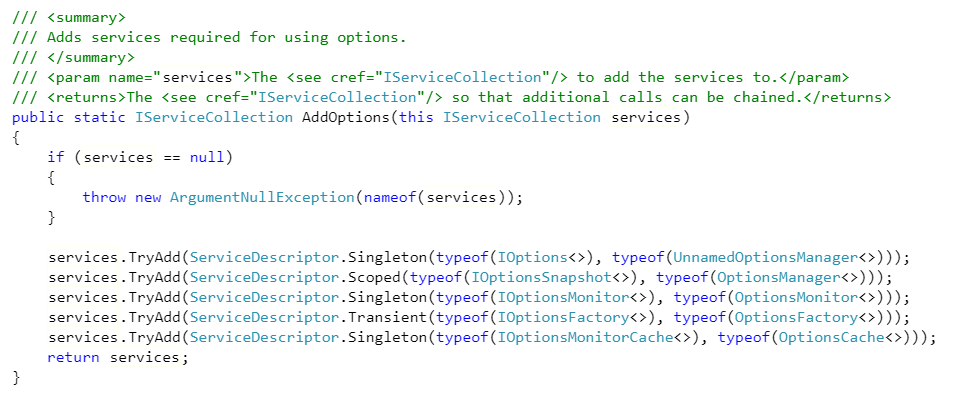.NET Core基础篇之:配置文件读取
配置文件是每个项目最基础的部分,也是不可或缺的部分,比如:数据库连接、中间件属性等常见的配置。
今天这篇文章主要内容就是,在.Net Core项目中怎样去读取配置文件并使用。
###提前准备
appsettings.json文件
{
"User": {
"userName": "赵一",
"userAge": 18
}
}
对应实体模型
public class UserOption
{
public string userName { get; set; }
public int userAge { get; set; }
}
###常规读取
#####1、注册 在 startup 类中注册,主要用到的是 Configure 方法:
services.Configure<UserOption>(Configuration.GetSection("User"));
#####2、控制器中注入并读取
public class HomeController : ControllerBase
{
private readonly UserOption user;
public HomeController(IOptions<UserOption> userOptions)
{
user = userOptions.Value;
}
[HttpGet]
public string Get()
{
return $"姓名:{user.userName},年龄:{user.userAge} ";
}
}
输出结果:
姓名:赵一,年龄:18
###嵌套读取 我们对
appsettings.json文件做一点小小的改动,增加一个子节点
child:
{
"User": {
"userName": "赵一",
"userAge": 18,
"child": {
"userName": "赵一的崽",
"userAge": 2
}
}
}
再对注册的代码做一点小小的修改:
services.Configure<UserOption>(Configuration.GetSection("User:child"));
输出结果:
姓名:赵一的崽,年龄:2
###分实例读取 这个时候需求又有变化了,需要同时读取
User与
child节点的数据,我们试试下面的方法看可行不可行:
// 注册
services.Configure<UserOption>(Configuration.GetSection("User"));services.Configure<UserOption>(Configuration.GetSection("User:child"));// 控制器
public class HomeController : ControllerBase
{
private readonly UserOption user;
private readonly UserOption child;
public HomeController(IOptions<UserOption> userOptions, IOptions<UserOption> childOptions)
{
user = userOptions.Value;
child = childOptions.Value;
}
[HttpGet]
public string Get()
{
return $"姓名:{user.userName},年龄:{user.userAge} \r\n姓名:{child.userName},年龄:{child.userAge}";
}
}
输出结果很显然满足不了我们的需求:
姓名:赵一的崽,年龄:2 姓名:赵一的崽,年龄:2
有的小伙伴肯定会说,在实体模型内在加一个子节点字段。这样肯定是没问题的,但是与常规读取方式就没什么两样了。
这里我要说的是分实例读取,引入
Configure的另一个重载方法,与之前不同的是多了一个参数
name:
public static IServiceCollection Configure<TOptions>(this IServiceCollection services, string name, IConfiguration config) where TOptions : class;
下面我们重新注册:
services.Configure<UserOption>("father", Configuration.GetSection("User"));
services.Configure<UserOption>("son", Configuration.GetSection("User:child"));
在控制器构造函数中注入,也引入了一个新的接口对象:
IOptionsMonitor
public class HomeController : ControllerBase
{
private readonly UserOption user;
private readonly UserOption child;
public HomeController(IOptionsMonitor<UserOption> userOptions, IOptionsMonitor<UserOption> childOptions)
{
user = userOptions.Get("father");
child = childOptions.Get("son");
}
[HttpGet]
public string Get()
{
return $"姓名:{user.userName},年龄:{user.userAge} \r\n姓名:{child.userName},年龄:{child.userAge}";
}
输出结果:
姓名:赵一,年龄:18 姓名:赵一的崽,年龄:2
其实还有一个接口对象能实现这样的效果:
IOptionsSnapshot,那
IOptionsMonitor与
IOptionsSnapshot有什么不同呢?请接着往下看。
###IOptionsMonitor与IOptionsSnapshot的不同之处
我们先来看看微软官方的注释:
IOptionsMonitor
//
// 摘要:
// Used for notifications when TOptions instances change.
//
// 类型参数:
// TOptions:
// The options type.
public interface IOptionsMonitor<out TOptions>
{
//
// 摘要:
// Returns the current TOptions instance with the Microsoft.Extensions.Options.Options.DefaultName.
TOptions CurrentValue { get; }
//
// 摘要:
// Returns a configured TOptions instance with the given name.
TOptions Get(string name);
//
// 摘要:
// Registers a listener to be called whenever a named TOptions changes.
//
// 参数:
// listener:
// The action to be invoked when TOptions has changed.
//
// 返回结果:
// An System.IDisposable which should be disposed to stop listening for changes.
IDisposable OnChange(Action<TOptions, string> listener);
}
IOptionsSnapshot
//
// 摘要:
// Used to access the value of TOptions for the lifetime of a request.
//
// 类型参数:
// TOptions:
// Options type.
public interface IOptionsSnapshot<out TOptions> : IOptions<TOptions> where TOptions : class, new()
{
//
// 摘要:
// Returns a configured TOptions instance with the given name.
TOptions Get(string name);
}
从字面上理解,
IOptionsMonitor建议在配置信息更改后需要通知的场景下使用,所以多了个
OnChange的方法;而
IOptionsSnapshot翻译过来的意思是:用于在请求的生命周期内访问配置,有点难以理解哈,我们接下来用代码来验证一下。
###IOptionsMonitor 与 IOptionsSnapshot的生命周期 我们对实体模型再做一点小小的修改,增加一个 guid 字段,并给上默认值:
public class UserOption
{
public string userName { get; set; }
public int userAge { get; set; }
public Guid guid { get; set; } = Guid.NewGuid();
}
我们再次运行程序:
father — 姓名:赵一,年龄:19,编号:e0d71f47-e8f1-4a6d-875e-2074c985f4a0 son — 姓名:赵一的崽,年龄:3,编号:d865151b-f9bf-4eff-bb4e-8ab6dc61160c
然后不停的刷新页面会发现,
father的编号没有发生任何编号,而
son的编号每次刷新都会改变。这是不是比较像我们注册时所用到的三种模式:
services.AddScoped(); services.AddTransient(); services.AddSingleton()
其中
father类似
AddSingleton,
son则类似
AddScoped与
AddTransient。
其实只要看一看源码就知道了:

###IOptionsMonitor的OnChange调用方式
userOptions.OnChange((user,name)=> { Console.WriteLine(user.userName +"-"+ name); });
###无文件配置 无文件配置就是不需要以静态文件的方式进行配置。相关信息在配置一次后就不用再做修改,我们可以采用无文件配置的方式,比如我们熟悉的
AddCors跨域配置
services.AddCors(op => {
op.AddPolicy(CorsName, set => {
set.SetIsOriginAllowed(origin => true).AllowAnyHeader().AllowAnyMethod().AllowCredentials();
});
});
我们对之前的注册方法进行一下改动:
services.Configure<UserOption>(c =>
{
c.userName = "钱二";
c.userAge = 60;
});
控制器注入采用常规的注入方式,最终输出结果:
姓名:钱二,年龄:60
以上就是本篇文章的全部内容了,因为时间有限,所以讲到的内容比较少,以后时间充裕之后再做相关补充。
分享一个源码查看网站:https://source.dot.net/
- .NET Core类库中读取配置文件
- .NET Core简单读取json配置文件
- .Net Core从命令行读取配置文件
- 使用VS Code开发.Net Core 2.0 MVC Web应用程序教程之三(配置文件读取)
- [.NET Core] 简单读取 json 配置文件
- NET Core开发-读取配置文件Configuration
- 关于.NET Core 读取appSettings配置文件,中文乱码
- .Net Core配置文件读取整理
- .NET Core 中读取appsettings.json配置文件的方法
- .net core 读取配置文件
- .net core 学习笔记(5)-配置文件读取
- 使用.net core读取Json文件配置
- .NET Core 读取配置文件
- 使用.net core读取Json文件配置
- .net core 使用 ConfigurationManager 读取config配置文件
- .Net Core 读取配置文件
- .Net Core 读取配置文件 appsettings.json
- 干货:.net core实现读取appsettings.json配置文件(建议收藏)
- .net core 2.0 读取配置文件
- 干货:.net core实现读取自定义配置文件,有源代码哦
